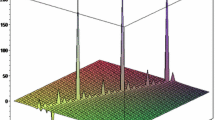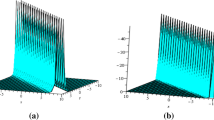Abstract
We have presented an unified scheme to express a class of system of equations in two variables into a Liénard–Levinson–Smith (LLS) oscillator form. We have derived the condition for limit cycle with special reference to Rayleigh and Liénard systems for arbitrary polynomial functions of damping and restoring force. Krylov–Boguliubov (K–B) method is implemented to determine the maximum number of limit cycles admissible for a LLS oscillator atleast in the weak damping limit. Scheme is illustrated by a number of model systems with single cycle as well as the multiple cycle cases.
Similar content being viewed by others
References
Murray, J.D.: Mathematical Biology. Springer, Berlin (1989)
Murray, J.D.: Lectures on Non-linear Differential Equation Models in Biology. Oxford University Press, Oxford (1977)
Epstein, I.R., Pojman, J.A.: An Introduction to Nonlinear Chemical Dynamics: Oscillations, Waves, Patterns, and Chaos. Oxford University Press, New York (1998)
Strogatz, S.H.: Nonlinear Dynamics and Chaos: With Applications to Physics, Biology, Chemistry, and Engineering. Westview Press, Boulder (1994)
Goldbeter, A., Berridge, M.J.: Biochemical Oscillations and Cellular Rhythms: The Molecular Bases of Periodic and Chaotic Behaviour. Cambridge University Press, Cambridge (1996)
Mickens, R.E.: Oscillations in Planar Dynamic Systems, vol. 37. World Scientific, Singapore (1996)
Ross, S.L.: Differential Equations. Wiley, Hoboken (1984)
Arnold, V.I., Ilyashenko, Y.: Ordinary Differential Equations, Encyclopedia Mathematical Science, 1st edn. Springer, Berlin (1988)
Birkhoff, G.D.: Dynamical Systems. A.M.S Publications, Providence (1927)
Stoker, J.: Nonlinear Vibrations in Mechanical and Electrical Systems. Wiley Classics Library. Wiley, Hoboken (1992)
Smale, S.: Differentiable dynamical systems. Bull. Am. Math. Soc. 73, 747–817 (1967)
Jordan, D.W., Smith, P.: Nonlinear Ordinary Differential Equations: An introduction for Scientists and Engineers, 4th edn. Oxford University Press, Oxford (2007)
Lavrova, A.I., Postnikov, E.B., Romanovsky, Y.M.: Brusselator an abstract chemical reaction? Physics-Uspekhi 52(12), 1239 (2009)
Ghosh, S., Ray, D.S.: Liénard-type chemical oscillator. Eur. Phys. J. B 87, 65 (2014)
Kaiser, F.: Theory of Resonant Effects of RF and MW Energy, pp. 251–282. Springer, Boston (1983)
Kaiser, F., Eichwald, C.: Bifurcation structure of a driven, multi-limit-cycle van der pol oscillator (i): the superharmonic resonance structure. Int. J. Bifurc. Chaos 01(02), 485–491 (1991)
Ghosh, P., Sen, S., Riaz, S.S., Ray, D.S.: Controlling birhythmicity in a self-sustained oscillator by time-delayed feedback. Phys. Rev. E 83, 036205 (2011)
Rand, R.H.: Lecture notes on nonlinear vibrations (2012)
Ghosh, S., Ray, D.S.: Rayleigh-type parametric chemical oscillation. J. Chem. Phys. 143(12), 124901 (2015)
Perko, L.: Differential Equations and Dynamical Systems, vol. 7, 2nd edn. Springer, Berlin (1996)
Liénard, A.: Rev. Gen. Electricite 23, 901 (1928)
Levinson, N., Smith, O.K.: Duke Math. J. 9, 382 (1942)
Levinson, N.: Ann. Math. 45, 723 (1944)
Saha, S., Gangopadhyay, G.: Isochronicity and limit cycle oscillation in chemical systems. J. Math. Chem. 55, 887–910 (2017)
Smale, S.: Mathematical problems for the next century. Math. Intell. 20(2), 7–15 (1998)
Gaiko, V.A.: Limit cycles of liénard-type dynamical systems. Cubo 10, 115–132 (2008)
Das, D., Banerjee, D., Bhattacharjee, J.K., Mallik, A.K.: Counting limit cycles with the help of the renormalization group. Eur. Phys. J. D 61, 443–448 (2011)
Das, D., Banerjee, D., Bhattacharjee, J.K.: Finding limit cycles in self-excited oscillators with infinite-series damping functions. Eur. Phys. J. D 69, 85 (2015)
Dutta, A., Das, D., Banerjee, D., Bhattacharjee, J.K.: Estimating the boundaries of a limit cycle in a 2D dynamical system using renormalization group. Commun. Nonlinear Sci. Numer. Simul. 57, 47–57 (2018)
Krylov, N.M., Bogolyubov, N.N.: Introduction to Non-linear Mechanics. Princeton University Press, Princeton (1947)
Chen, L.Y., Goldenfeld, N., Oono, Y.: Renormalization group theory for global asymptotic analysis. Phys. Rev. Lett. 73, 1311–1315 (1994)
Chen, L.Y., Goldenfeld, N., Oono, Y.: Renormalization group and singular perturbations: multiple scales, boundary layers, and reductive perturbation theory. Phys. Rev. E 54, 376–394 (1996)
Sarkar, A., Guha, P., Ghose-Choudhury, A., Bhattacharjee, J.K., Mallik, A.K., Leach, P.G.L.: On the properties of a variant of the riccati system of equations. J. Phys. A: Math. Theor. 45(41), 415101 (2012)
Giacomini, H., Neukirch, S.: Number of limit cycles of the liénard equation. Phys. Rev. E 56, 3809–3813 (1997)
Sarkar, A., Bhattacharjee, J.K., Chakraborty, S., Banerjee, D.B.: Center or limit cycle: renormalization group as a probe. Eur. Phys. J. D 64, 479–489 (2011)
Kadji, H.G.E., Yamapi, R., Chabi Orou, J.B.: Synchronization of two coupled self-excited systems with multi-limit cycles. Chaos: Interdiscip. J. Nonlinear Sci. 17(3), 033113 (2007)
Kadji, H.G.E., Chabi Orou, J.B., Yamapi, R., Woafo, P.: Nonlinear dynamics and strange attractors in the biological system. Chaos Solitons Fractals 32(2), 862–882 (2007)
Yamapi, R., Nana Nbendjo, B.R., Kadji, H.G.E.: Dynamics and active control of motion of a driven multi-limit-cycle van der pol oscillator. Int. J. Bifurc. Chaos 17(04), 1343–1354 (2007)
Yamapi, R., Filatrella, G., Aziz-Alaoui, M.A.: Global stability analysis of birhythmicity in a self-sustained oscillator. Chaos: Interdiscip. J. Nonlinear Sci. 20(1), 013114 (2010)
Chéagé Chamgoué, A., Yamapi, R., Woafo, P.: Dynamics of a biological system with time-delayed noise. Eur. Phys. J. Plus 127, 59 (2012)
Saha, S., Gangopadhyay, G.: When an oscillating center in an open system undergoes power law decay. J. Math. Chem. 57, 750–758 (2018)
Lins, A., de Melo, W., Pugh, C.C.: On Liénard’s Equation, Lecture Notes in Mathematics. Springer, Berlin (1977)
Rychkov, G.S.: The maximal number of limit cycles of the system \({\dot{y}}=-x, {\dot{x}}=y-\sum \nolimits _{i=0}^{2} a_{i+1} x^{2i+1}\) is equal to two. Differ. Uravn. 11(2), 390–391 (1975)
Blows, T.R., Lloyd, N.G.: The number of small-amplitude limit cycles of linard equations. Math. Proc. Camb. Philos. Soc. 95(2), 359366 (1984)
Acknowledgements
Sandip Saha acknowledges RGNF, UGC, India for the partial financial support.
Author information
Authors and Affiliations
Corresponding author
Ethics declarations
Conflict of interest
The authors declare that they have no conflict of interest.
Additional information
Publisher's Note
Springer Nature remains neutral with regard to jurisdictional claims in published maps and institutional affiliations.
Appendix: Lotka–Volterra System
Appendix: Lotka–Volterra System
To obtain the LLS form of Lotka–Volterra System [3,4,5], let us set \(z=\delta x+\beta y\) then \({\dot{z}}=\alpha \delta x-\beta \gamma y=u\) \(\implies \) \(x=\frac{{\dot{z}}+\gamma z}{(\alpha +\gamma )\delta }\) and \(y=\frac{-{\dot{z}}+\alpha z}{(\alpha +\gamma )\beta }\). After taking t derivative upon \({\dot{z}}\) one can have,
The fixed point (0, 0) gives a saddle solution which is not of any interest in the present context. Choosing the remaining non-zero fixed point for further investigations, and after taking perturbation \(z=\xi +z_s\) around the fixed point \(z_s=\alpha +\gamma =\delta x_s+\beta y_s \ne 0\), one can get the LLS form with \(F(\xi ,{\dot{\xi }})=a_1 \xi +a_2 {\dot{\xi }}\) with \(a_1=\frac{\alpha -\gamma }{\alpha +\gamma }\) and \(a_2= - \frac{1}{\alpha +\gamma }\). It is to be noted that \(G(\xi )\) contains nonlinearity with \(G(\xi )=\omega ^2 \xi +a_3 \xi ^2\) where \(\omega =\sqrt{\alpha \gamma }=Im(\lambda )\)(\(+ve\) sense) and \(a_3=\frac{\alpha \gamma }{\alpha +\gamma }\). After introducing a small parameter \(\epsilon _1\) (say) in the constants, \(a_i, b_i\) such that \(a_i=\epsilon _1 b_i, i=1,2,3\) the above equation reduces to \(\ddot{\xi }+\epsilon _1 (b_1 \xi +b_2 {\dot{\xi }}) {\dot{\xi }}+\omega ^2 \xi +\epsilon _1 b_3 \xi ^2=0\).
Rights and permissions
About this article
Cite this article
Saha, S., Gangopadhyay, G. & Ray, D.S. Reduction of Kinetic Equations to Liénard–Levinson–Smith Form: Counting Limit Cycles. Int. J. Appl. Comput. Math 5, 46 (2019). https://doi.org/10.1007/s40819-019-0628-9
Published:
DOI: https://doi.org/10.1007/s40819-019-0628-9




